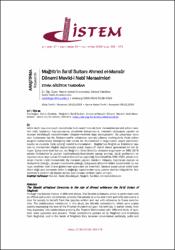| dc.contributor.author | Gözütok Tamdoğan, Zehra | |
| dc.date.accessioned | 2022-05-11T14:34:33Z | |
| dc.date.available | 2022-05-11T14:34:33Z | |
| dc.date.issued | 2019 | |
| dc.identifier.issn | 1304-0618 | |
| dc.identifier.issn | 2602-408X | |
| dc.identifier.uri | https://doi.org/10.31591/istem.633615 | |
| dc.identifier.uri | https://app.trdizin.gov.tr/makale/TXprME16RXhNUT09 | |
| dc.identifier.uri | https://hdl.handle.net/20.500.11776/7967 | |
| dc.description.abstract | İslâm tarihi boyunca çeşitli devletlerde hem resmî hem de halk merasimleriyle icrâ edilen mevlid-i nebî, toplumun kaynaşmasına, yönetimle buluşmasına, merasim dolayısıyla yazılan veokunan mevlidiyyât kasidelerinden nasiplenmelerine kapı aralayacaktır. Bu çalışmaya konuolan kutlamalar ise Hz. Muhammed’in vefatından sonraki yıllarda medhiyelerle ifade edilensevginin kutlamalara dönüşmüş hali olarak Hz. Muhammed’in doğumunun çeşitli semboller,kaside ve dualarla ifade edildiği mevlid kutlamalarıdır. Bağdat’tan Mağrib ve Endülüs’e taşınan bu merasimler Mağrib topraklarında siyasî, tasavvufî, edebî olarak geleneksel bir hal almıştır. Çalışmanın özel konusu ise Mağrib’in ikinci Endülüs olmasını engelleyen ve 986/1578yılında Portekizliler’le yapılan Vadilmehazin/Kasrülkebir savaşı sonrası, Sa’dî şeriflerinin birnişanesi olsun diye sultan Ahmed el-Mansûr’un yaptırdığı Kasrülbedî’de 999/1591 yılında kutlanan mevlid-i nebî merasimidir. Bu merasim yapılan mekânın ihtişamı, hazırlanan yiyecek vehediyelerin bolluğu, okunan kasidelerin çokluğu dolayısıyla dönemin İslâm devletlerinin bu konuya verdikleri özel önemi göstermesi açısından da önemlidir. Sadece siyasî yahut edebî özellikleri değil aynı zamanda İslâm’ın doğduğu topraklardan epey uzakta olan bu bölgede Hz. Muhammed’e özlemin de ifadesi olması bakımından tarihteki yerini almıştır. | en_US |
| dc.description.abstract | Through the Islamic History in different states, The Mawlid al-Nabawi, which is performed both as official and public ceromonies, enables the society to unite and meet authority and opens a door for society to benefit from the qasidas written and red with reference to these ceromonies. The celebrations mentioned in this study are Mawlid celebrations, which were praise poems expressing the love of the Prophet Muhammad upon his birthday in earlier times, then they expanded into celebrations praising the Prophet Muhammad with different kinds of symbols, odes (qasidas) and prayers. These celebrations passed on to Maghreb and Andalusia from Baghdad, and in the lands of Maghreb they became conventional politically, sufic and literarily. In particular, the subject of this study is the ceremony of Mawlid al-Nabawi performed in the year of 999/1591 in Kasrülbedi built by sultan Ahmad al-Mansur, as a sign of the sharifs of Sa’di dynasty, after the war of Vadilmehazin/Kasrülkebir/Alcazarquivir with Portugueses in the year of 986/1578 which also prevents Maghreb from being the second Andalusia. This ceremony is also important as it shows the special interest of Islamic states of that era to this issue with the magnificence of place, the abundance of food and presents served and qasidas red during the celebration. It is imbedded in history not just for the political or literary features of it but also because of being the expression of yearning for the Prophet Muhammad in an area far away from the lands where Islam born. | en_US |
| dc.language.iso | tur | en_US |
| dc.identifier.doi | 10.31591/istem.633615 | |
| dc.rights | info:eu-repo/semantics/openAccess | en_US |
| dc.title | Mağrib'in Sa'dî Sultanı Ahmed el-Mansûr Dönemi Mevlid-i Nebî Merasimleri | en_US |
| dc.title.alternative | The Mawlid al-Nabawi Ceremony in the Age of Ahmad al-Mansur the Sa'di Sultan of Maghreb | en_US |
| dc.type | article | en_US |
| dc.relation.ispartof | İstem | en_US |
| dc.department | Fakülteler, İlahiyat Fakültesi, İslam Tarihi ve Sanatları Bölümü | en_US |
| dc.identifier.volume | 0 | en_US |
| dc.identifier.issue | 34 | en_US |
| dc.identifier.startpage | 459 | en_US |
| dc.identifier.endpage | 475 | en_US |
| dc.institutionauthor | Gözütok Tamdoğan, Zehra | |
| dc.identifier.trdizinid | TXprME16RXhNUT09 | en_US |



















